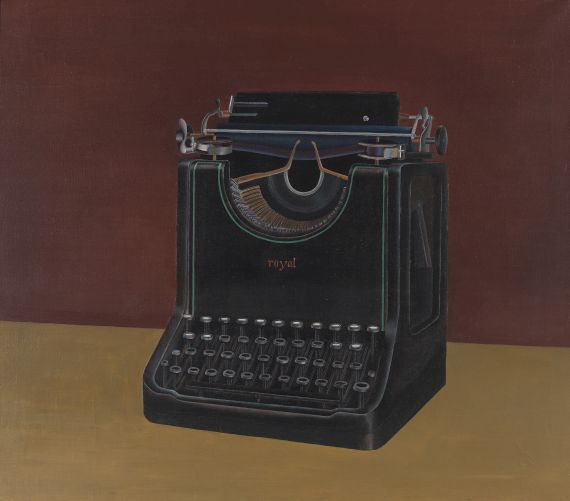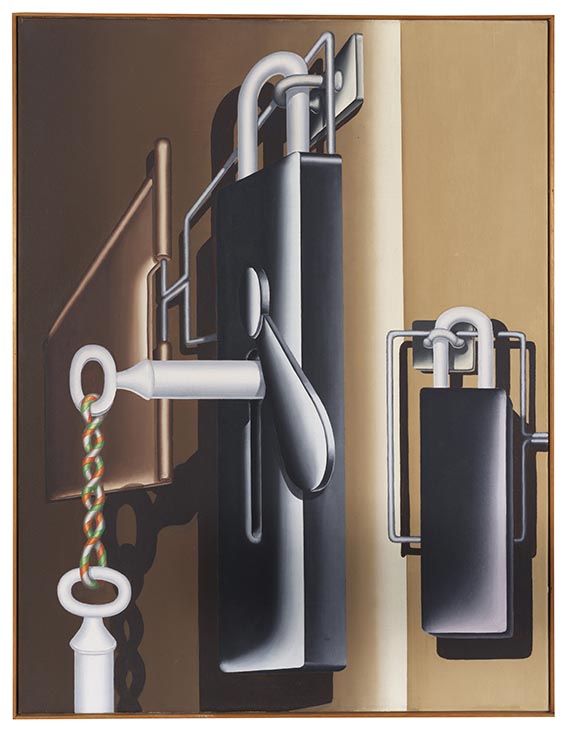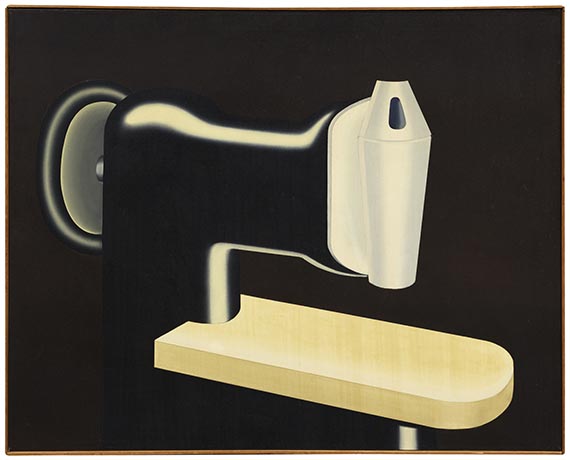Frame image
73
Konrad Klapheck
Die Stunde des Gerichtes, 1961.
Oil on canvas
Estimate:
€ 120,000 - 150,000
$ 139,200 - 174,000
Konrad Klapheck
1935 - 2023
Die Stunde des Gerichtes. 1961.
Oil on canvas.
Signed and inscribed with an indication of the direction on the reverse of the canvas, titled on the stretcher. 80 x 70 cm (31.4 x 27.5 in).
[AR].
• This early work exhibits Klapheck's characteristic, seductive play on linguistic and visual ambiguity.
• Ingenious variation on the faucet theme, one of the artist's ten main subjects, offering free association to a courtroom gavel.
• From his most productive period: Today, most of his paintings from the 1960s are in museum collections.
• Featured in the early Klapheck exhibition at the Kestner-Gesellschaft, Hanover, in 1966.
• Across the Atlantic Ocean: from Leo Castelli's legendary New York Pop-Art gallery.
The work is registered under the work number 71 in the artist's archive. We are grateful to Rabbi Prof. Dr. Elisa Klapheck for her kind expert advice.
PROVENANCE: Leo Castelli, New York (with the label on the stretcher).
Whitney Straight, London.
Private collection, North Rhine-Westphalia.
Since then in family ownership.
EXHIBITION: Konrad Klapheck, Kestner Gesellschaft Hanover, November 11–December 11, 1966, cat. no. 71 (no illustration), here with the note: “Freie Variation des Wasserhahn-Themas. Assoziation: Gerichtsglocke.” (cf. p. 30).
LITERATURE: José Pierre, Konrad Klapheck, Nuremberg 1970, cat. no. 71.
Sotheby's London, Impressionist, Modern, and Contemporary Paintings and Drawings – Watercolors and Sculptures, May 28, 1986, lot 292 (illustrated in color on p. 103).
Called up: December 5, 2025 - ca. 19.24 h +/- 20 min.
1935 - 2023
Die Stunde des Gerichtes. 1961.
Oil on canvas.
Signed and inscribed with an indication of the direction on the reverse of the canvas, titled on the stretcher. 80 x 70 cm (31.4 x 27.5 in).
[AR].
• This early work exhibits Klapheck's characteristic, seductive play on linguistic and visual ambiguity.
• Ingenious variation on the faucet theme, one of the artist's ten main subjects, offering free association to a courtroom gavel.
• From his most productive period: Today, most of his paintings from the 1960s are in museum collections.
• Featured in the early Klapheck exhibition at the Kestner-Gesellschaft, Hanover, in 1966.
• Across the Atlantic Ocean: from Leo Castelli's legendary New York Pop-Art gallery.
The work is registered under the work number 71 in the artist's archive. We are grateful to Rabbi Prof. Dr. Elisa Klapheck for her kind expert advice.
PROVENANCE: Leo Castelli, New York (with the label on the stretcher).
Whitney Straight, London.
Private collection, North Rhine-Westphalia.
Since then in family ownership.
EXHIBITION: Konrad Klapheck, Kestner Gesellschaft Hanover, November 11–December 11, 1966, cat. no. 71 (no illustration), here with the note: “Freie Variation des Wasserhahn-Themas. Assoziation: Gerichtsglocke.” (cf. p. 30).
LITERATURE: José Pierre, Konrad Klapheck, Nuremberg 1970, cat. no. 71.
Sotheby's London, Impressionist, Modern, and Contemporary Paintings and Drawings – Watercolors and Sculptures, May 28, 1986, lot 292 (illustrated in color on p. 103).
Called up: December 5, 2025 - ca. 19.24 h +/- 20 min.
Despite the incredible precision and perceived aloofness of his depictions, Konrad Klapheck's works always carry a subtle humor and remarkable human warmth. His machines are both familiar and strange, almost personified, raising questions about identity and social order. The present “Stunde des Gerichts” (Hour of Judgment) from 1961 is an early work in which he stages one of his “ten main objects”: the faucet (cf. Konrad Klapheck, Meine Gegenstände, 1973).
In one of the most famous works from this series, “Die Sexbombe und ihr Begleiter” (The Sex Bomb and Her Companion) from 1963, he depicts the entire fixture, including hose and spray head, with one part of the faucet symbolizing the woman and another part the man.
From the artist's writings, we also know what he associated with the faucet, and with bathrooms in general: "Bathrooms had always attracted me. How much physical history they contained, what a sensual encounter with one's own physicality they offered!“ He describes his family's bathrooms as ”places of delight" (cf. Konrad Klapeck, Warum ich male, 1984).
In “Stunde des Gerichts” from 1961, a close-up of two taps in different colors is shown, presumably one warm and one cold, which, similar to “Die Sexbombe und ihr Begleiter,” can be interpreted as representing female and male parts. Along with the title, however, another level of meaning opens up here, because the shape of the taps is reminiscent of a court bell, which serves to call for order in the courtroom during proceedings. It almost seems as if this association is meant to be a call for dispute resolution between the sexes, although, as is so often the case, the final interpretation is left to the viewer.
Even at the time of its creation, “Stunde des Gerichtes” must have emanated that special fascination and appeal that permeates Konrad Klapheck’s entire oeuvre. The work featured the early comprehensive Klapheck exhibition at the Kestner-Gesellschaft in Hanover in 1966. It was once owned by the legendary New York art dealer Leo Castelli, who had contracted Andy Warhol in 1964. Castelli visited Konrad Klapheck in his studio in Germany in 1962, purchasing four of his paintings and thus recognizing the outstanding quality of Klapheck's painting even before the American artist was discovered. At the time, Klapheck anticipated elements of Pop Art and Photorealism. [AR]
In one of the most famous works from this series, “Die Sexbombe und ihr Begleiter” (The Sex Bomb and Her Companion) from 1963, he depicts the entire fixture, including hose and spray head, with one part of the faucet symbolizing the woman and another part the man.
From the artist's writings, we also know what he associated with the faucet, and with bathrooms in general: "Bathrooms had always attracted me. How much physical history they contained, what a sensual encounter with one's own physicality they offered!“ He describes his family's bathrooms as ”places of delight" (cf. Konrad Klapeck, Warum ich male, 1984).
In “Stunde des Gerichts” from 1961, a close-up of two taps in different colors is shown, presumably one warm and one cold, which, similar to “Die Sexbombe und ihr Begleiter,” can be interpreted as representing female and male parts. Along with the title, however, another level of meaning opens up here, because the shape of the taps is reminiscent of a court bell, which serves to call for order in the courtroom during proceedings. It almost seems as if this association is meant to be a call for dispute resolution between the sexes, although, as is so often the case, the final interpretation is left to the viewer.
Even at the time of its creation, “Stunde des Gerichtes” must have emanated that special fascination and appeal that permeates Konrad Klapheck’s entire oeuvre. The work featured the early comprehensive Klapheck exhibition at the Kestner-Gesellschaft in Hanover in 1966. It was once owned by the legendary New York art dealer Leo Castelli, who had contracted Andy Warhol in 1964. Castelli visited Konrad Klapheck in his studio in Germany in 1962, purchasing four of his paintings and thus recognizing the outstanding quality of Klapheck's painting even before the American artist was discovered. At the time, Klapheck anticipated elements of Pop Art and Photorealism. [AR]
73
Konrad Klapheck
Die Stunde des Gerichtes, 1961.
Oil on canvas
Estimate:
€ 120,000 - 150,000
$ 139,200 - 174,000
Buyer's premium, taxation and resale right compensation for Konrad Klapheck "Die Stunde des Gerichtes"
This lot can be purchased subject to differential or regular taxation, artist‘s resale right compensation is due.
Differential taxation:
Hammer price up to 1,000,000 €: herefrom 34 % premium.
The share of the hammer price exceeding 1,000,000 € is subject to a premium of 29 % and is added to the premium of the share of the hammer price up to 1,000,000 €.
The share of the hammer price exceeding 4,000,000 € is subject to a premium of 22 % and is added to the premium of the share of the hammer price up to 4,000,000 €.
The buyer's premium contains VAT, however, it is not shown.
Regular taxation:
Hammer price up to 1,000,000 €: herefrom 29 % premium.
The share of the hammer price exceeding 1,000,000 € is subject to a premium of 23% and is added to the premium of the share of the hammer price up to 1,000,000 €.
The share of the hammer price exceeding 4,000,000 € is subject to a premium of 15% and is added to the premium of the share of the hammer price up to 4,000,000 €.
The statutory VAT of currently 7 % is levied to the sum of hammer price and premium.
We kindly ask you to notify us before invoicing if you wish to be subject to regular taxation.
Calculation of artist‘s resale right compensation:
For works by living artists, or by artists who died less than 70 years ago, a artist‘s resale right compensation is levied in accordance with Section 26 UrhG:
4 % of hammer price from 400.00 euros up to 50,000 euros,
another 3 % of the hammer price from 50,000.01 to 200,000 euros,
another 1 % for the part of the sales proceeds from 200,000.01 to 350,000 euros,
another 0.5 % for the part of the sale proceeds from 350,000.01 to 500,000 euros and
another 0.25 % of the hammer price over 500,000 euros.
The maximum total of the resale right fee is EUR 12,500.
The artist‘s resale right compensation is VAT-exempt.
Differential taxation:
Hammer price up to 1,000,000 €: herefrom 34 % premium.
The share of the hammer price exceeding 1,000,000 € is subject to a premium of 29 % and is added to the premium of the share of the hammer price up to 1,000,000 €.
The share of the hammer price exceeding 4,000,000 € is subject to a premium of 22 % and is added to the premium of the share of the hammer price up to 4,000,000 €.
The buyer's premium contains VAT, however, it is not shown.
Regular taxation:
Hammer price up to 1,000,000 €: herefrom 29 % premium.
The share of the hammer price exceeding 1,000,000 € is subject to a premium of 23% and is added to the premium of the share of the hammer price up to 1,000,000 €.
The share of the hammer price exceeding 4,000,000 € is subject to a premium of 15% and is added to the premium of the share of the hammer price up to 4,000,000 €.
The statutory VAT of currently 7 % is levied to the sum of hammer price and premium.
We kindly ask you to notify us before invoicing if you wish to be subject to regular taxation.
Calculation of artist‘s resale right compensation:
For works by living artists, or by artists who died less than 70 years ago, a artist‘s resale right compensation is levied in accordance with Section 26 UrhG:
4 % of hammer price from 400.00 euros up to 50,000 euros,
another 3 % of the hammer price from 50,000.01 to 200,000 euros,
another 1 % for the part of the sales proceeds from 200,000.01 to 350,000 euros,
another 0.5 % for the part of the sale proceeds from 350,000.01 to 500,000 euros and
another 0.25 % of the hammer price over 500,000 euros.
The maximum total of the resale right fee is EUR 12,500.
The artist‘s resale right compensation is VAT-exempt.
Headquarters
Joseph-Wild-Str. 18
81829 Munich
Phone: +49 89 55 244-0
Fax: +49 89 55 244-177
info@kettererkunst.de
Louisa von Saucken / Undine Schleifer
Holstenwall 5
20355 Hamburg
Phone: +49 40 37 49 61-0
Fax: +49 40 37 49 61-66
infohamburg@kettererkunst.de
Dr. Simone Wiechers / Nane Schlage
Fasanenstr. 70
10719 Berlin
Phone: +49 30 88 67 53-63
Fax: +49 30 88 67 56-43
infoberlin@kettererkunst.de
Cordula Lichtenberg
Gertrudenstraße 24-28
50667 Cologne
Phone: +49 221 510 908-15
infokoeln@kettererkunst.de
Hessen
Rhineland-Palatinate
Miriam Heß
Phone: +49 62 21 58 80-038
Fax: +49 62 21 58 80-595
infoheidelberg@kettererkunst.de
We will inform you in time.




 Lot 73
Lot 73 




